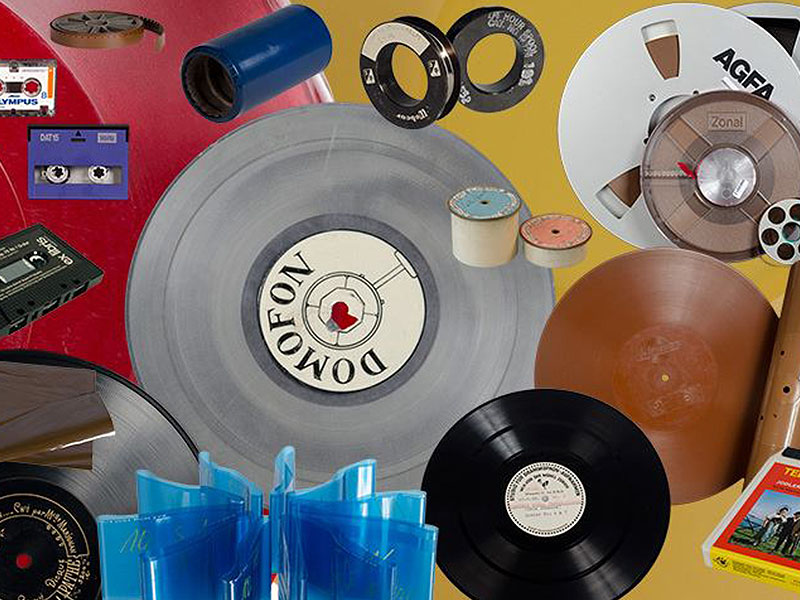SOUND
Numerous radio broadcasts and recordings of music and speech mean that our country’s multifaceted history
and its cultural diversity are still audible. They need to be copied and restored to preserve them for the future;
sound recordings and sound technology are short-lived: decay and obsolescence affect both old analog recordings and modern digital media.
This also applies in a modified form to the archiving of digitally produced audio files. Rapid progress in information technology
necessitates a careful choice of digital formats and concepts for long-term storage.
ACTIVITIES

Different formats of sound recordings. Photography: Fonoteca Nazionale Svizzera
Even in the age of MP3 and podcasts, alongside the music industry’s mass production there are still large numbers of unique copies on many different media formats. These were collected in private and public archives and libraries for research purposes. All these collections are currently faced with the problem that their storage media are decaying and – what is almost worse – playback equipment and techniques have long since disappeared. Both problems, decay and obsolescence, affect both old, analogue media and modern digital storage devices. Dehydration, chemical decay processes and ever-accelerating innovation cycles all threaten our acoustic heritage.
Memoriav activities in Sound
- Memoriav initiates and supports projects for the preservation and increased availability of cultural, political and music ethnological sound recordings. On the one hand, the recordings must be saved from decay or before the playback devices disappear, and on the other hand the recordings must be made available to the public.
Explore the projects (in German/French/Italian) - In the projects it supports, Memoriav also ensures these recorded witnesses are catalogued using a high-quality system, which is the only way to make sure they can be found and are accessible.
- An important task is the constant monitoring of technical developments, as these witnesses of the past must remain in good and authentic quality for our descendents.
- And finally, the decision must often be made to narrow down a selection of recordings, because they cannot all be saved. In this matter Memoriav makes sure the collaboration with partner institutions is organised according to the best knowledge and conscience.
- Through extension course offerings and publications, Memoriav sensitises interested parties and professional circles to the preservation of sound recordings.
- In the excellence network restoration and archiving experts tackle the contextual and technical aspects of the long-term preservation of Sound recordings.
Go to the sound excellence network (in German/French/Italian)
RECOMMENDATIONS
Selected information from the areas of archiving, cataloguing and digitisation, as well as practical advice on the care, handling and storage of audiovisual recordings.
Memoriav recommendations
Memoriav publishes recommendations for the preservation of audiovisual recordings. They were developed by the experts participating in Memoriav’s competence networks or result from Memoriav projects.
Since March 2022, the Memoriav recommendations are available as an online publication in German and French.
External recommendations
International recommendations and standards from the field of audiovisual cultural heritage preservation, published by expert organisations or specialised institutions:
list of links
